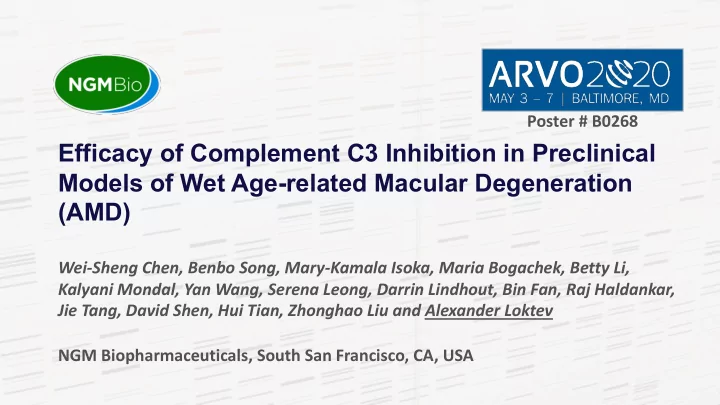

Poster # B0268 Efficacy of Complement C3 Inhibition in Preclinical Models of Wet Age-related Macular Degeneration (AMD) Wei-Sheng Chen, Benbo Song, Mary-Kamala Isoka, Maria Bogachek, Betty Li, Kalyani Mondal, Yan Wang, Serena Leong, Darrin Lindhout, Bin Fan, Raj Haldankar, Jie Tang, David Shen, Hui Tian, Zhonghao Liu and Alexander Loktev NGM Biopharmaceuticals, South San Francisco, CA, USA
Poster # B0268 Financial Disclosures: All authors are employees of NGM Biopharmaceuticals, South San Francisco, CA, USA
Dysregulation of Complement Contributes to Development and Progression of Advanced Age-related Macular Degeneration (AMD) AMD is the leading cause of blindness in • the US and the developed world Human genetics and other evidence • implicate dysregulation of complement system in pathogenesis of both forms of advanced AMD – Geographic Atrophy and Choroidal Neovascularization (CNV) CNV lesion: the abnormal new vessel growth from the choriocapillaris that extends through Bruch’s membrane into the sub-RPE and/or subretinal space 3
Complement Activation Pathways Converge on Complement C3 4
Laser-induced CNV Model Mechanistically Recapitulates Wet AMD Laser-induced CNV model: one of the most widely used models that recapitulates the VEGF dependent angiogenic aspect of wet AMD, including activation of microglia and recruitment of myeloid immune cells Fundus photo Fluorescein angiogram Isolectin-IB4 staining Eyecup flatmount 5
Complement Inhibition Ameliorates Laser-induced CNV in Mice Reduced macrophage recruitment Reduced CNV lesion size in C3aR Inactivation of C3a or C5a function is protective in in C3aR and C5aR knockout mice and C5aR knockout mice mouse laser-induced CNV model ( Nozaki M., et al., C3aR KO WT C5aR KO PNAS 2006) F4/80 + /CD11c - CNV lesion size is reduced in C3aR and C5aR knockout • mice or by treatment with anti-C3a, anti-C5a antibodies and with C3aR antagonist Recruitment of neutrophils and macrophages is • ������������������������������������������������������ diminished Concentration of VEGF is reduced in C3aR or C5a • knockout mice ����������������������������������������������������� C3a and C5a activate RPE to secrete VEGF and MCP-1 • Nozaki M., et al., PNAS 2006 Nozaki M., et al., PNAS 2006 ������������ ��� ����������� �������� ������������ ��� Blocking of complement C5 activation by genetic CNV lesion size is reduced by ������������������������������������������������������������������������������������ Reduced macrophage recruitment, ������������������������������������������������������ intravitreous anti-C5 antibody MCP-1 and VEGF expression upon knockout or by blocking antibody is protective in anti-C5 antibody treatment mouse laser-induced CNV model ( Bora N., et al., J IgG1 Anti-C5 IgG1 Anti-C5 Immunol 2006; Jo D., et al., Oncotarget 2017) • CNV lesion size is reduced by treatment with anti-C5a antibodies F4/80 Recruitment of macrophages (F4/80+) to CNV lesions is • ��������������������������������������������������������������������������������������� reduced �������������������������������������������������������������������������������������������������������������������������������������������� ���������������������������������������� ������������������������������������������������������������������������ • Concentrations of MCP-1 and VEGF in choroid/ sclera is reduced Jo D., et al., Oncotarget 2017 Jo D., et al., Oncotarget 2017 6 ��������������������������������������������������������� ������������������������������������������������������������������������������������ ��������������������������������������������������������������������������������������� �������������������������������������������������������������������������������������������������������������������������������������������� ���������������������������������������� ������������������������������������������������������������������������
Genetic Inactivation of Complement C3 in Mice Ameliorates CNV Phenotype in Laser-induced Model Reduced laser-induced CNV lesion Reduced recruitment of Genetic inactivation of complement C3 is protective size in C3 knockout mice CD11b + /Ly6C + granulocytes and in in mouse laser-induced CNV model (Tan X., et al., Sci. C3 knockout mice Reports 2015; Poor S., et al., IOVS 2014; Bora P., et al., J WT WT Immunol 2005) Laser-induced CNV lesions were significantly smaller in • C3 knockout (C3 KO) mice than in wild-type mice • Reduced intraocular granulocytes, C3 KO C3 KO macrophage/monocyte subsets in C3 KO mice at days 1- 3 after laser injury. • Expression of Vegfa164 was reduced in intraocular inflammatory Ly6C hi macrophages/monocytes of C3 KO mice Tan X., et al., Sci. Reports 2015 Tan X., et al., Sci. Reports 2015 Reduced recruitment of Alternative complement inhibition CD11b + /F4/80 + Ly6C hi macrophages reduces CNV lesion size Multiple studies demonstrate reduction in and Vegfa164 in C3 knockout mice CNV phenotype upon complement inhibition through modulation of downstream inflammatory signaling Rohrer B., et al., IOVS 2009 Tan X., et al., Sci. Reports 2015 7 ���������������������� ������������������ ��������� �������������������
Genetic Deletion of Complement C3 Reduces Vascular Leakage in Mouse Laser-induced CNV Model Fluorescein angiography C3 KO WT Day 0 -52% Fundus Animals: C3 KO mice (JAX #32042, backcrossed to p<0.05 C57BL/6, N2) males, 8 week-old (WT: N=10, KO: N=11) • Vascular leakage, as determined by FA, was reduced by 52% in C3 KO mice compared to WT CNV Lesion Size Day 7 FA littermate controls • A trend of decreased CNV size in C3 KO mice was observed but did not reach statistical significance • Mixed genetic background may contribute to insignificant reduction in CNV Day 7 IB4 8
Anti-Complement C3 Antibodies to Interrogate Complement Biology in Rodents • We generated a murine complement C3 specific inhibitory antibody anti-C3.105B9 – Binds to intact complement C3 with high affinity K D =74 pM – Blocks complement activation by classical and alternative pathways with IC 50 5.4 nM and 3.3 nM respectively • Anti-C3d.3D29 antibody specific to C3d can be used to detect complement activation in vivo , including marking laser-induced lesions in the retina (Thurman J., et al., JCI 2013) Anti-C3.105B9 blocks classical and Anti-C3.105B9 binding to alternative hemolytic assays murine C3 measured by SPR 120 (% normalized to control) AP IC50=3.3nM 100 CP IC50=5.4nM Hemolysis 80 60 40 20 0 K D 7.4x10 -11 M 10 -1 10 0 10 1 10 2 10 3 Log Concentration (nM) 9
Complement Activation and C3d Deposition in the Retina Peaks at Day 2 after Laser-induced Injury Anti-C3d.3D29 intensity per CVN lesion area *** p<0.001 vs C3 KO *** Animals : C57BL/6 and C3 KO mice 2-3 per group/time point *** WT C3 KO Day 3 Day 1 Day 2 Day 3 Day 7 O K 3 Green: anti-C3d.3D29 Red: Isolectin B4 C • Complement activation in the retina, measured by staining for deposition of C3d with anti- C3d.3D29, peaks at Day 2 after laser injury • C3d deposition in vivo can be detected by intravenous administration of Alexa 488 labeled anti- C3d.3D29 at Day 1 followed by live fluorescence imaging 10
Recommend
More recommend